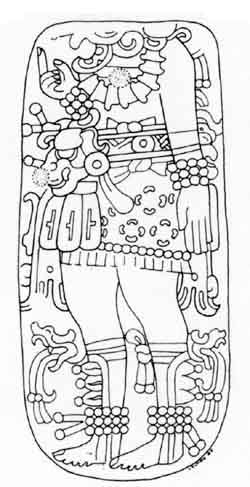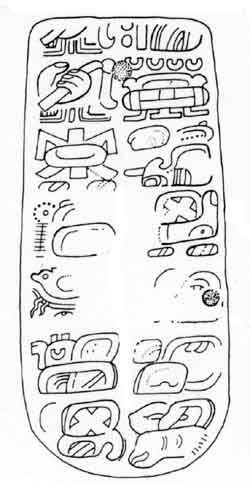Mayavase.com Research Material



K2839a and K2839b
Text from The Blood of Kings, Schele and Miller, 1986
| PLATE 22 Celt fragment Early Classic period, AJ). 250400 Jadeite 11.7 x 5.4 cm Dumbarton Oaks, Washington, D.C. This lovely light green celt is one of three originally hung below the heads on a royal belt. Looted from a tomb in Precolumbian times, it was broken, then redrilled for horizontal suspension. The drawing of the figure is Early Classic in style, but the style of the glyphs suggests a date that is earlier, perhaps even Protoclassic. The image of a standing king (2839a) incised on the front surface of the celt shows him holding one arm rigidly at his side, the other raised to his shoulder with a finger pointing upward. While his head is missing, the bottom detail of his ear flare assemblage and what may be the bifurcated scroll of a facemask can be seen below the upper edge. A chain of bell-shaped jades hangs around his neck, and he wears beaded cuffs on his wrists. Mat and disk signs mark his belt, and a jaguar head is mounted on its front. Three celts cut with interior T-shapes hang below the jaguar God's head. Because only the tip of a muzzle and forehead of a rear head are visible behind his right wrist, we cannot identify the other god he wore. The skirt is made of a jaguar pelt, and the bifurcated loincloth he wears is characteristic of early royal dress. The rear and front loin apron are finished with a serpent-fret border. The king's leg cuffs are the most unusual item of dress. A knot with an open-mouthed zoomorph is tied around each leg below the knee. This knot is connected to a panel inset with three pointed shapes that appear to wrap around his leg. At the base of the panels are beaded cuffs, and a panel covers his ankles. The rendering of the toes as a scalloped line is unusual. THE INSCRIPTION The celt inscription (2839b) begins with four glyphs that record a period ending in a most unusual form. The first two glyphs are partially obliterated by the break, but it can be reconstructed as "8 or 9 baktuns were completed." The next two appear to record that "4 katuns were completed," although both the katun glyph and the number are very unusual. Many of the remaining glyphs; cannot be read, but B4 is a "kin-in-hand" glyph that appears repeatedly in Protoclassic texts, but not later. A6 is also a very early form of the ahau title. The final sign is the earliest known example of a title prominent in royal names of the Classic period: the main sign here is a penis. Although this text is not fully deciphered, it still provides considerable information. The last four (or perhaps six) glyphs name the ruler pictured on the opposite side. The ritual shown is probably a periodending rite, and the early form of the glyphs supports the earlier position of the period-ending notation. If the baktun coefficient is 8, then the date is 8.4. 0. 0. 0, or July 15, A. D. 150. The later position, 9.4.0.00, places the celt in the year A.D. 514, which seems to be too late for the style of drawing and glyphs. |
|